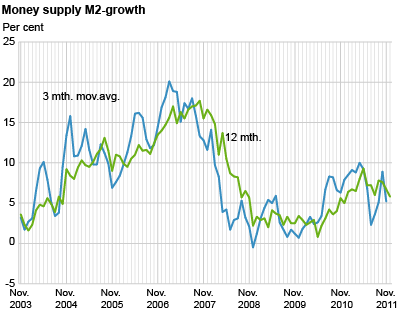Content
Published:
This is an archived release.
Decrease in money supply growth
The twelve-month growth in total money supply (M2) was 5.8 per cent to end-December, down from 6.7 per cent to end-November. Non-financial enterprises, municipal government and other financial corporations contributed to the lower growth rate.
The total money supply amounted to NOK 1 702 billion at end-December, up from NOK 1 696 billion at end-November.
Increase in money supply growth for households
Households’ money supply constitutes more than half of the total money supply. At end-December it accounted for NOK 929 billion, up from NOK 910 billion the previous month. The twelve-month growth in households’ money supply increased from 6.7 per cent to end-November to 7.6 per cent to end-December.
The growth in households’ money supply was higher than the growth in households’ gross domestic debt, which amounted to 7.3 per cent to end-December, according to the credit indicator C2 . For more information on the financial position of households, see the financial accounts in the national accounts .
Decrease in the money supply growth for non-financial enterprises
Non-financial enterprises’ money supply amounted to NOK 567 billion at end-December, up from NOK 559 billion at end-November. The twelve-month growth also decreased from 5.3 per cent to end-November to 4.4 per cent to end-December. Non-financial enterprises’ money supply constituted about 44 per cent of their gross domestic debt measured by the credit indicator C2 at end-December.
Decrease in the money supply growth for municipal government
Municipal government’s money supply amounted to NOK 65 billion at end-December, down from NOK 71 billion the previous month. The twelve-month growth rate decreased from 12.8 per cent to end-November to 3.2 per cent to end- December.
Decrease in the growth for other financial enterprises
Other financial enterprises’ money supply amounted to NOK 142 billion at end-December, down from NOK 156 billion at end-November. The twelve-month growth was 1.7 per cent to end-December, down from 10 per cent the previous month.
| June 2011 | July 2011 | August 2011 | September 2011 | October 2011 | November 2011 | December 2011 | |||||||||||||||||||||||||||||||||||||||||||||||||||||||||||||||||||||||||
|---|---|---|---|---|---|---|---|---|---|---|---|---|---|---|---|---|---|---|---|---|---|---|---|---|---|---|---|---|---|---|---|---|---|---|---|---|---|---|---|---|---|---|---|---|---|---|---|---|---|---|---|---|---|---|---|---|---|---|---|---|---|---|---|---|---|---|---|---|---|---|---|---|---|---|---|---|---|---|---|
| M0 - 12 mth. | -8.6 | 0.2 | 8.4 | 3.6 | 53.9 | 28.1 | 9.8 | ||||||||||||||||||||||||||||||||||||||||||||||||||||||||||||||||||||||||
| M1 - 12 mth. | 7.0 | 7.9 | 6.3 | 7.9 | 7.9 | 6.0 | 4.7 | ||||||||||||||||||||||||||||||||||||||||||||||||||||||||||||||||||||||||
| M2 - 12 mth. | 7.2 | 7.2 | 6.0 | 7.8 | 7.6 | 6.7 | 5.8 | ||||||||||||||||||||||||||||||||||||||||||||||||||||||||||||||||||||||||
| M2 - 3 mth. moving average1 | 6.8 | 2.3 | 3.6 | 5.1 | 8.9 | 5.2 | |||||||||||||||||||||||||||||||||||||||||||||||||||||||||||||||||||||||||
| M2 households - 12 mth. | 5.9 | 6.6 | 6.5 | 6.5 | 5.9 | 6.7 | 7.6 | ||||||||||||||||||||||||||||||||||||||||||||||||||||||||||||||||||||||||
| M2 non-financial enterprises - 12 mth. | 9.8 | 7.7 | 7.2 | 8.2 | 8.8 | 5.3 | 4.4 | ||||||||||||||||||||||||||||||||||||||||||||||||||||||||||||||||||||||||
| 1 | Annualised figure. |
Composition of money supply
The broad monetary aggregate M2 amounted to NOK 1 702 billion at end-December, of which the major part, 91.5 per cent, consisted of bank deposits. In comparison, notes and coins only accounted for 2.9 per cent. The rest of the broad monetary aggregate mainly consisted of shares in money market funds and certificates of deposits, which accounted for 5.2 and 0.4 per cent respectively.
Base money increase
Base money (M0) amounted to NOK 147 billion at end-December, up from NOK 119 billion the previous month. The twelve-month growth in M0 fell from 28.1 per cent to end-November to 9.8 per cent to end-December.
|
Please note that figures for shares of money market funds have been revised. The downward revisions have an effect on i.a. the twelve-month growth of M2 dating back to September 2010. |
|
The money supply (broad monetary aggregate) M2 consists of notes and coins, unrestricted bank deposits, certificates of deposit and units in money market funds owned by the money-holding sector, i.e. households, non-financial enterprises, municipalities and financial enterprises other than state lending institutions, banks and money market funds. The base money (M0) is defined as banks’ and the money-holding sector's notes and coins and deposits in Norges Bank. Banks’ deposits in Norges Bank comprise current account (sight) deposits and fixed rate (time) deposits (F-deposits), from Norges Bank’s monthly balance sheet. Other financial enterprises include financial enterprises other than lending institutions, banks and money market funds. |
|
Growth based on the three-month moving average is defined as growth in average money supply (seasonally-adjusted figures) in the latest three-month period in relation to the previous three-month period. The growth is adjusted for exchange rate valuation changes and statistical breaks as an annualised figure. The calculation is centred; in other words, the observation is set at the middle month of the latest three-month period. |
The statistics is published with Monetary aggregates.
Contact
-
Statistics Norway's Information Centre
E-mail: informasjon@ssb.no
tel.: (+47) 21 09 46 42

